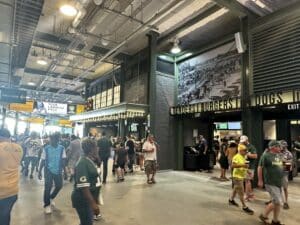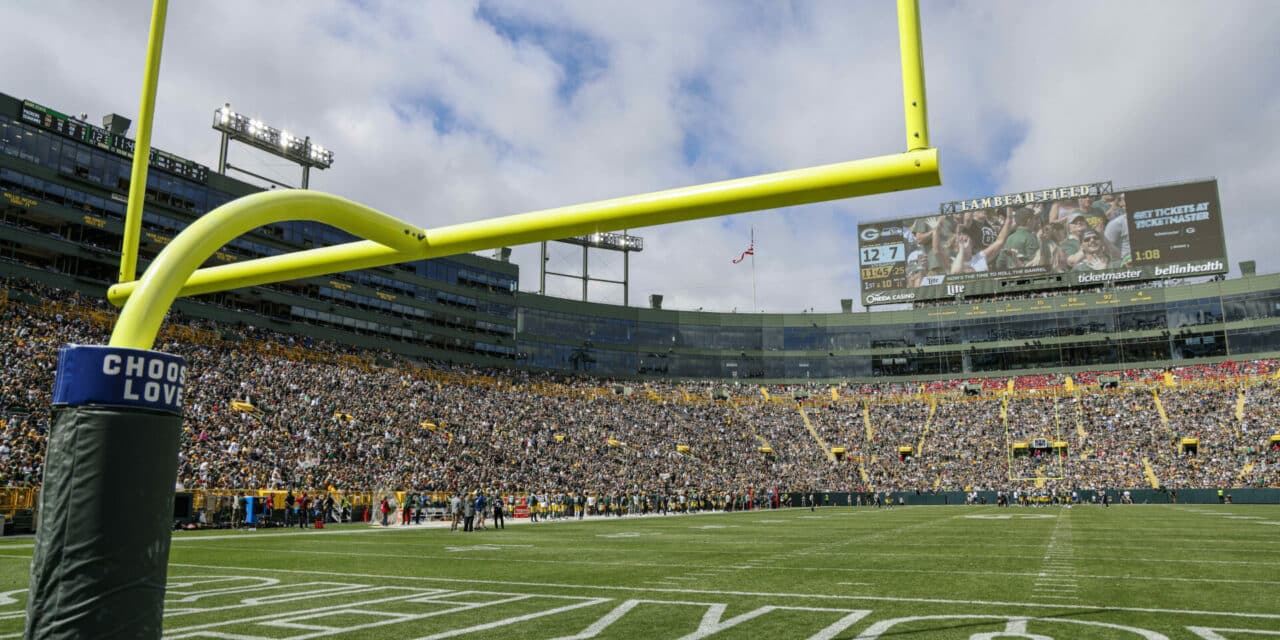SAY CHEESE: Lambeau Field, shown here during a Green Bay Packers preseason game in August, has a goal to convert all concession stands to grab-and-go markets by 2026, team officials said. (AP Photo)
Packers have invested $600 million in upgrades since 2003
The Green Bay Packers expect to convert virtually every concession stand at Lambeau Field to grab-and-go markets after seeing revenues surge as fans embrace the food service trend sweeping across the big leagues.
The process is roughly 60% complete ahead of Sunday’s regular-season home opener against New Orleans, with a typical sellout crowd of 80,000 expected.
The Packers and Delaware North Sportservice, their food provider, started the conversion four years ago with portable stands at the NFL stadium for expedite speed of service for concessions.
For the 2023 season, 10 traditional belly-up stands are now grab-and-gos on the 300 level in the upper deck, said Scott Thompson, the Packers’ assistant director of business analytics and food and beverage.
The current upgrades cost about $100 million, which extends to 60 new LED videoboards on the upper concourse to help keep fans connected to the game outside the seating bowl. Daktronics produced the screens with displays in three different sizes, with the biggest boards running 12 feet wide.
All told, the Packers have invested $600 million over the past 20 years to improve Lambeau Field since a $295 million expansion was completed in 2003, said team spokesman Aaron Popkey. The expansion, whose centerpiece was the five-story Atrium, was a public-private partnership. Since that time, the Packers have privately funded all renovations, Popkey said.
The newest grab-and-gos join other markets already converted on the club level and some on the 100 level. They’re a mix of cold beverage and hot food locations.
About 15 to 20 belly-ups remain to be converted in the future, most on the 100 level, which is the main concourse. The Packers and Sportservice are “navigating” the financials and internal approvals before moving ahead to complete the conversion by 2026, Thompson said.

GRAB JOINT: All concession stands in the upper deck at Lambeau Field were converted to grab-and-go markets. (Courtesy team)
The 2025 NFL Draft takes place in Green Bay, which will put the overall project on pause for six months, said Tom Olson, Sportservice’s vice president of operations in Milwaukee.
“The nice thing is fans have picked it up quickly,” Thompson said. “We’re able to get two-thirds more fans through grab-and-gos than with the belly-ups. Our goal is to convert every stand; it might not be 100%, based on space limitations, but we’re pushing in that direction.”
Sports architect Rossetti, the same firm the Packers hired to help develop Titletown, the team’s entertainment district across the street from Lambeau Field, has been designing the grab-and-go retrofits.
For the Packers, unlike most NFL teams, incorporating new technology and pursuing innovation in general sometimes takes a backseat to the cold reality that an outdoor stadium faces in a harsh winter climate.
In Green Bay, the team must examine whether things will work in the elements at a venue where temperatures can often plunge below zero with the wind chill toward the end of the season in December-January.
That’s been the case as the Packers and Sportservice study the autonomous checkout model and the three major players in that space, Amazon, Zippin and AiFi. They’re closely monitoring the evolution of that technology, but haven’t been able to identify which vendor would be the right fit for Lambeau Field.
Last Sunday, Week 2 of the NFL season, Thompson, as part of his due diligence, attended the Packers-Falcons game at Mercedes Benz Stadium in Atlanta. He spent half of one quarter observing the AiFI checkout free stands to see how fans interact with them.
The retractable-roof stadium opened six years ago. The Packers must contend with a building that opened in 1957.
“A lot of these companies we work with, we encourage them to throw their technology in a freezer overnight and then try to fire it up, because that’s how it has to operate toward the end of the season,” Thompson said.
“They all laugh, and we tell them we’re not joking,” he said. “In fact, the freezer may not get cold enough for how it has to operate. For arenas and indoor stadiums, it’s an easy add. We have unique circumstances. It’s great technology and we’ll be excited once we can hit the green light on it. Those companies are going to get a lot of data when they can test it in a cold environment.”
Editor’s Note: This story has been updated.







